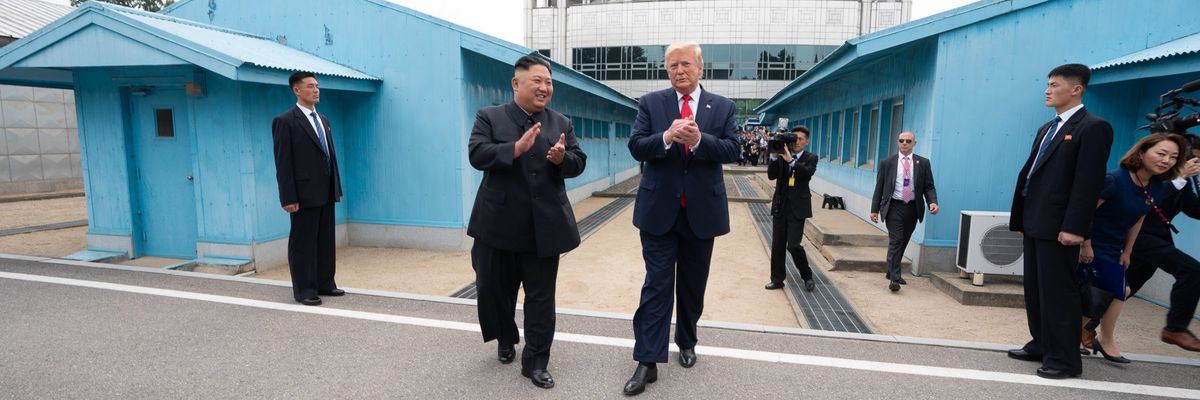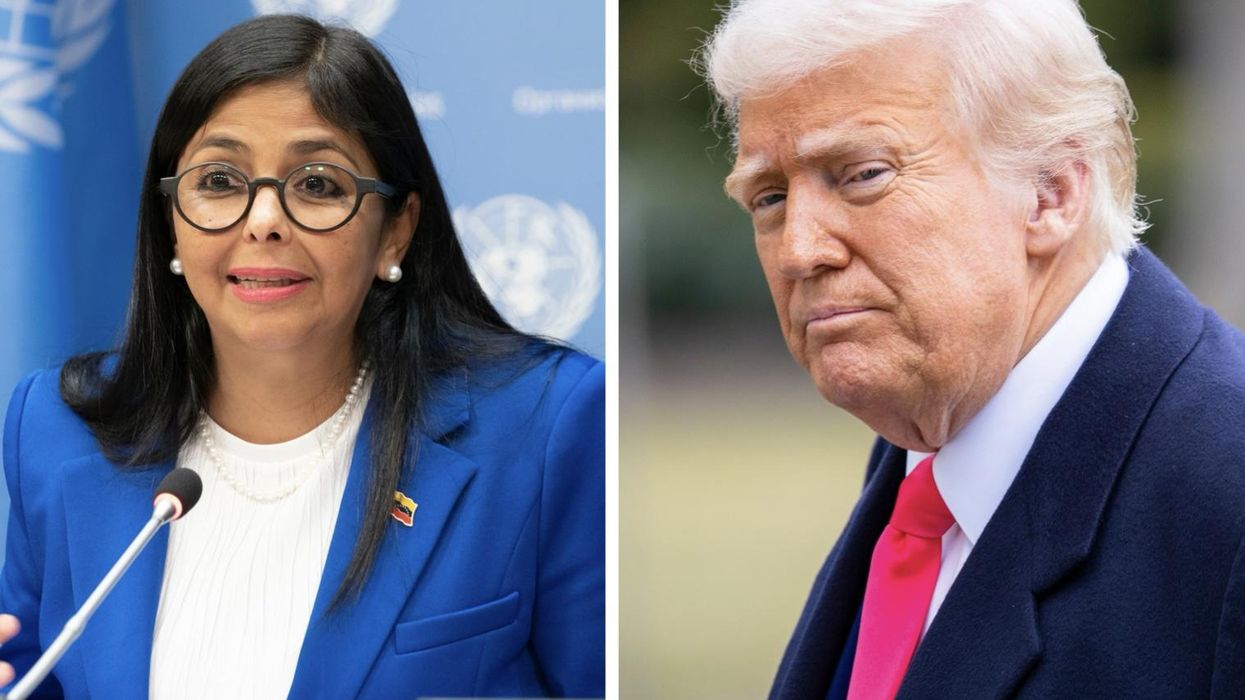With opinion polls showing Donald Trump ahead of Joe Biden in the 2024 race, Washington policymakers are contemplating the possibility of another Trump administration.
No doubt there would be dramatic changes in U.S. foreign policy. Including, it appears, in Washington’s approach to North Korea.
As Politico reported: “Donald Trump is considering a plan to let the Democratic People’s Republic of Korea keep its nuclear weapons and offer its regime financial incentives to stop making new bombs, according to three people briefed on his thinking.”
This would overturn decades of international insistence that the North eschew nuclear weapons, commonly called CVID: complete, verifiable, irreversible dismantlement/denuclearization. Until now, questioning this policy triggered wild wailing, gnashing of teeth, and rending of garments among Korea-watchers.
The conventional wisdom is that Washington must stand firm — until the end of time, or beyond, if necessary — despite the growing North Korean nuclear arsenal. Pyongyang has enough fissile material to make at least 45-55 weapons, and perhaps twice that number, though estimates vary widely.
Moreover, the DPRK continues to add nukes. One controversial study warned that the North could amass as many as 242 weapons in the next few years, which would place it ahead of Israel, Pakistan, India, and the United Kingdom.
Virtually no one believes that Pyongyang will denuclearize. Only South Africa, with just six weapons (and another being constructed), has eliminated an existing arsenal. Almost certainly disarming the DPRK would require either defeat or collapse of the Kim dynasty. Regarding North Korea, fantasy has seemingly become policy.
However, it appears that Trump is prepared to overturn conventional wisdom when it comes to Pyongyang — again. After threatening war in 2017, he turned to summitry with Kim Jong-un, a switch widely denounced in Washington. Distrust of Trump as a negotiator was pervasive, with the greatest fear that he would succeed and agree to something other than CVID. After the 2019 Hanoi summit collapsed without a deal, Kim appears to have decided that Trump was unwilling to agree to sanctions relief without a commitment to full denuclearization. The former then ended his dialogue with the US (and South Korea).
Biden continues to insist on CVID, instructing the DPRK not to conduct another nuclear test. Despite his proposals for contact, which at times came perilously close to begging, Kim has refused to talk. Rather, the latter is expanding North Korea’s nuclear capability, testing ballistic missiles, launching satellites, developing submarine-launched and tactical weapons, and threatening first use of nukes.
These efforts may now be aided by Russia, which is relying on the North to provide artillery shells and perhaps more for the Ukraine war.
The future looks no better. Last year after the Supreme People’s Assembly enshrined the North’s nuclear status in law, Kim declared that “As long as nuclear weapons exist on Earth, and imperialism and the anti-North Korean maneuvers of the US and its followers remain, our road to strengthening our nuclear force will never end.”
This policy, he added, is “irreversible.” He is likely strengthening his nuclear deterrent to prepare for talks with Washington — presumably offering to trade nuclear limits for sanctions relief.
Policymakers almost uniformly reject this course since arms control won’t deliver denuclearization, Washington’s preferred outcome. However, the result still would be better, likely far better, than Pyongyang continuing to augment its stockpile and replacing Pakistan as a global Nukes ‘R Us. However, that doesn’t matter to critics.
Some simply insist that the North cannot have nuclear weapons. Of course, it shouldn’t have them, but successive U.S. presidents repeating that point have left North Korea as an undisputed nuclear state.
Another argument is that dropping CVID would undermine the nonproliferation regime. However, the DPRK’s possession of nuclear weapons, not America’s recognition of that reality, poses the real nonproliferation challenge.
Another claim is that the Republic of Korea and Japan would doubt Washington’s commitment to denuclearization of the North. But Washington’s attitude matters little if North Korea rejects that objective. Alliance cooperation does not require blinkered dogmatic futility.
For some analysts the greatest fear is that acknowledging the North’s nuclear status would fuel ROK support for an independent nuclear deterrent. Again, pretending that the DPRK does not possess nuclear weapons does not make them disappear. Washington’s hapless CVID policy will not comfort South Koreans worried about nuclear threats from the North and Washington’s willingness to respond militarily.
Indeed, the latter poses the biggest problem for today’s Ostrich policy. Since everyone knows Pyongyang is expanding its arsenal and means of delivery, the critical question is what to do in response. South Koreans might accept the pretense that CVID is a serious objective so long as Washington is willing to risk the American homeland and potentially millions of American lives to defend the South in the event of war.
Alas, the “Washington Declaration,” which grew out of South Korean President Yoon Suk-yeol’s visit to the US, engaged in magical thinking. Announced the two governments: “The ROK has full confidence in U.S. extended deterrence commitments and recognizes the importance, necessity, and benefit of its enduring reliance on the U.S. nuclear deterrent.”
Wonderful rhetoric, and hardly surprising, given how well the two presidents got along. However, the more and more sophisticated North Korea’s armaments, the less credible this policy becomes.
The DPRK is not going to launch a first strike on America. Indeed, absent U.S. security guarantees to and troops in the South, Pyongyang would pay little more attention to Washington than to Brussels or, frankly, to New Delhi or Sydney. However, the U.S. is prepared to strike the North, and in the event of war almost certainly would attempt to overthrow the Kim dynasty.
Hence, Pyongyang’s desire for an expansive deterrent — a mix of tactical and strategic weapons, with the latter distributed among submarine- and land-based missiles, the latter sporting multiple warheads. What American president then would be so reckless and irrational to put South Korea before the U.S.? Defending the ROK, a country well able to protect itself, is not worth risking millions of Americans’ lives.
In short, no amount of presidential karaoke is likely to preserve confidence in extended deterrence once Pyongyang credibly threatens the U.S. homeland. The best way to at least moderate the North Korean nuclear threat would be to abandon the CVID campaign and instead promote arms control, meaningful and verifiable limits on the DPRK’s program in exchange for sanctions relief. And to do so sooner rather than later.
At least, setting realistic objectives would be more likely to yield success. And if diplomacy restrained the North, Washington could resurrect CVID in future negotiations. Perhaps North Korean policy, leadership, or regime will eventually change.
Donald Trump’s foreign policy mistakes were many, but on the North’s nuclear challenge he has been farsighted compared to most foreign policy analysts. That continues with his reported willingness to deal with the DPRK as it is, not how everyone wishes it were. North Korea is a nuclear state. It is time to confront that reality.
- Biden's North Korea policy is floundering in Trump territory ›
- Is President Biden daring North Korea to start a crisis? ›
- Are North Korea's latest threats rhetorical or real? | Responsible Statecraft ›
















